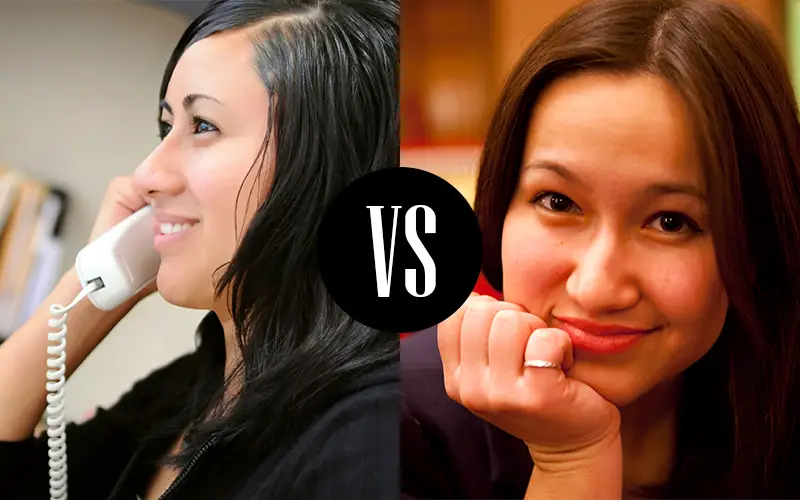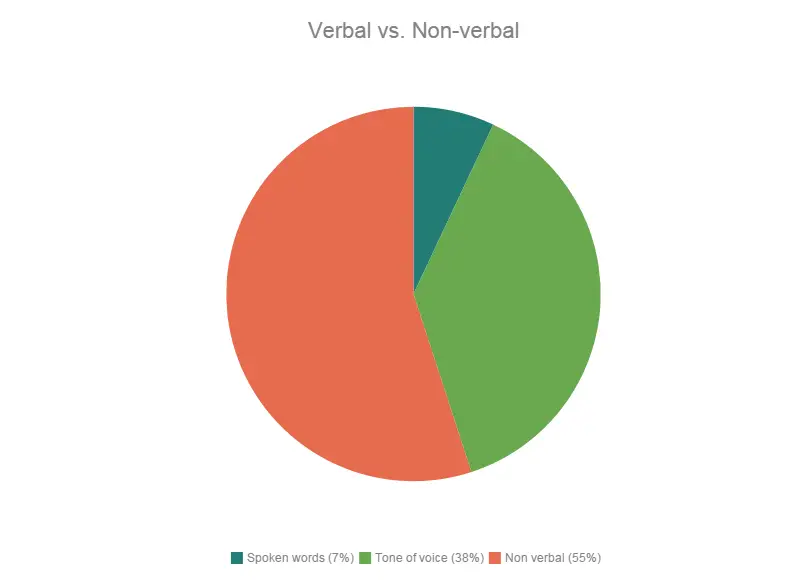Communication is the process of transferring message which happen with or without words. These are of two types: verbal and non-verbal.
The intended message is transferred to people non-verbally using
- proxemics (distance),
- kinesics (body language),
- haptics (touches),
- appearance
- eye contact, etc.
And verbally using words, which includes
- speaking
- writing
- detonation (dictionary meaning) or connotation (feelings associated with meaning of words)
- tone and volume
Both these modes of communication are used in parallel to generate the intended outcome.

What is Verbal communication?
Verbal communication is auditory communication with words. It is mostly face-to-face or written with the use of language as a means. Nowadays, technologies like phone and internet have allowed oral communication to take place without being in the same place or writing.
Here, tone and volume of the spoken words or sound matter the most along with the words. Similarly, detonation and connotation are other factors that sends intended meaning of message. So, choosing right words according to situations is important.
Verbal communication might fail in inter-cultural situations due to meanings and symbols being different.
What is Non-verbal communication?
Wordless communications fall under non-verbal communication. It is conveyed as visual cues. Body language, gestures, facial expressions, touch, etc. are few examples of non-verbal communication.
It is noticed and interpreted more than words. It also communicates more messages.
It is used to interpret whether verbal communication is true and authentic, or not.
Non- verbal communication can be different according to place, culture and individual differences. There is no specific interpretation, rather the interpretations are open.
Similarities between verbal and non-verbal communication
Verbal and non-verbal communications are not contradictory in their uses. They go side by side. Combination of verbal and non-verbal communication make communication effective. In most cases, one doesn’t exist without the other. For example, laughing at a joke and saying it is funny.
According to a researcher Wertheim, non-verbal communication plays different roles in communication. It can play one of these five roles: reinforcement, substitution, contradiction, accentuation and regulation.
Both forms of communications are learned and are not innate in most cases. There are some innate verbal or non-verbal communications like crying, groaning in pain, etc. Except those, people learn most of non-verbal communications like that of table manners and so on.
Differences between verbal and non-verbal communication

Mentioned below are the differences between verbal and non-verbal communication that make each of them unique.
Importance and structure
Different cultures have developed language and words through centuries into what it is today. This has made communication easier and reliable. This is why verbal communication is important.
- Verbal communication is a structured communication as it has grammar rules and gives clear messages.
- Non-verbal communication is not structured; it does not have specific patterns. It can be interpreted as anyones wish. however, non-verbal communication is important as it supports verbal communication by adding flavor to it. But, it does not happen the other way round.
Discretion and Continuousness
- Verbal communication has start point and stop points.
- Non-verbal communication keeps going on without interruptions. Even when alone, interpersonal processes keep occurring at individual level. Even after people stop talking, they keep showing non-verbal cues. For example, glares after a fight or smiles after something good.
Chances of Miscommunication
- Each word in verbal communication has distinct meanings and has less chance of being misinterpreted.
- There are about 4000 distinct facial expressions that people can make with 20 muscles in the face. Along with that, there are so many other types of non-verbal communications. So, there is a greater chance of those signs that can be misinterpreted
Neuro-physiological processing
- Verbal stimuli are interpreted by the left hemisphere of brain which helps in analyzing and reasoning. This happens most of the time but brain does not follow it all the time.
- Non-verbal communications are interpreted by right hemisphere of the brain. These interpretations involve spatial, pictorial and gestalt activities in the brain, and create elicit responses.
Time consumption
- Verbal communication is fast and efficient.
- Non-verbal communication is more time consuming than verbal communications. For example, sign language news is more time consuming than others presented verbally.
Miscommunication according to places and situations
- Verbal communication also has immediate feedback, whereas it is not always possible in non-verbal. This is because people do not show emotions right then but take some time.
- Miscommunication in verbal communication happens less than in non-verbal communication. For example, in Russia, smile is considered to be impolite. Whereas in most of other parts of the world it is a positive gesture.
But, this doesn’t mean non-verbal is misinterpreted in all the situations. It is better at communicating feelings and emotions, even though it is slow. It even shows what a sentence might mean in a particular situation. For example, a sarcastic sentence and a compliment seems the same verbally. But, the intentions can only be interpreted through non-verbal cues.
Presence and distance
- Verbal communication can use any means like letters, chat, phone, etc. Distance does not matter in verbal communication
- People must be face to face to show and receive non-verbal communication. Non-verbal communication cannot occur in long distance
Documentary Evidences
- Verbal communication are loud and people witness it. So, there can be documentary evidences of it as other people might have heard. It can be taken as an evidence.
- In non-verbal communication, many people do not witness and have less evidences. Conclusive documentary evidences are less in non-verbal communication. It only happens if there are eye-witnesses as it is visual cues.
Which is More in use
Albert Mehrabian had conducted a research on verbal and non-verbal communication in 1960. The study showed that nonverbal communication is more important than verbal.
According to it, 55% meaning of any message is generated by face and body. Another 38% is derived from the way anyone speaks (tone, volume, etc.) and only other 7% from words said. These three parts of communication are the 3 V’s.
This study shows that receivers take about 93 % from non-verbal communication and only 7 % from verbal communication.
And when verbal and non-verbal communication contradicts, non-verbal is mostly true. You should believe in non-verbal cues. People cannot control their non-verbal communications all the time and fake the non-verbal cues.
Uses of Verbal and Non-verbal Communication
The major use of verbal communication are to inform or impart knowledge, as words are very powerful. It can be used as a tool of persuasion. It is used to have debates, discuss and show creativity. It can also be used to establish relationships as words are used to express feelings. It is needed for social situations.
Whereas, non-verbal communication like touch and eye contact express closeness and emotions.
For example: Holding hands can express love better than words like “love you”. The 5 major uses of non-verbal communication are modifying speech, replacing speech, controlling communication, conveying personality and expressing emotions. It also helps in maintaining interpersonal relationships, supporting verbal communication and perform.
So, we can say verbal and non-verbal communication does not always have to be different. It also has many similarities and goes hand in hand.
